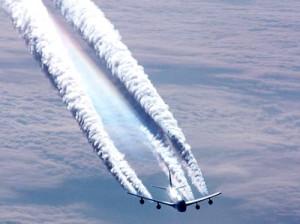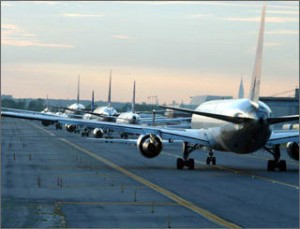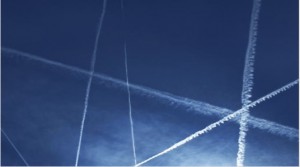Introduction
Greenhouse gas (GHG) emissions from the transport sector in most countries remain among the highest and most intransigent. Aviation shares the blame for this problem with cars, trucks, and ships. Currently aviation contributes about 5% of global GHG emissions, having increased by 110% between 1990 and 2008, while other sectors reduced their share of GHGs. Note 1. And aviation emissions are expected to continue to rise, doubling or tripling by 2050. On a smaller, personal scale, flying London to New York and back uses the same amount of emissions of an average person in the EU for heating a home for a year. Is it any wonder those in developing countries complain of the inequity in responsibility for GHG emissions.
As we ask in the sub-title, is the EU policy on airline pollution evolving or regressing? It’s regressing. From a fairly firm stance that would require any flight, from any air carrier, starting or ending in Europe to participate in the European Emissions Trading System (ETS), the present position of the EU is that only flights operating entirely within Europe airspace are covered by the ETS. How did the EU get here.
The earlier position was actually adopted in EU legislation in 2008 with international aviation emissions included in the EU ETS in 2012. But the policy created an uproar from the airline industry, through their respective national governments, including those stalwarts of aggressive action on climate change, the United States and China. It also led to a lawsuit by certain US airline carriers and their trade association against the EU.
The lawsuit was heard by the European Court of Justice which held, in December 2011, that the EU legislation’s extension of the ETS to aviation did not infringe on the principle of territoriality or sovereignty of non-EU countries; that the ETS did not constitute a tax, fee or charge on fuels (which would have violated the EU-US Air Transport Agreement); and that the uniform application of the ETS to European and non-European airlines was consistent with the Transport Agreement which prohibited discrimination between airlines on nationality grounds.
The court of public opinion was not as easy to satisfy, at least as regards the industry. The airlines continued to demand that the EU retreat, and they threatened non-compliance and retaliatory action if they were to be included in the ETS for all flights into and out of Europe.
Many found such complaints strikingly unfair. Airlines do not pay any aviation fuel tax, they do not pay any Value Added Tax (VAT), and they receive direct subsidies from governments for operations and infrastructure. The rest of us pay substantial fuel taxes (about 48c per litre) and VAT, and do not receive direct subsidies for running our lives.
 A vociferous argument by the airlines was that all this regulation was unnecessary as the airlines were already working on a solution within their own industry (IATA) and international organisations. Notably the Kyoto Protocol, in 1997, urged the developed countries to work out a deal to reduce aviation GHG emissions through the UN’s International Civil Aviation Organization (ICAO), instituted to develop international standards and practices for national civil aviation regulations.
A vociferous argument by the airlines was that all this regulation was unnecessary as the airlines were already working on a solution within their own industry (IATA) and international organisations. Notably the Kyoto Protocol, in 1997, urged the developed countries to work out a deal to reduce aviation GHG emissions through the UN’s International Civil Aviation Organization (ICAO), instituted to develop international standards and practices for national civil aviation regulations.
The negotiations between the ICAO and airlines industry focused over the past several decades on technological and operational improvements and especially industry efforts to reduce fuel usage, driven less by climate change worries than by need to reduce costs and sustain growth, which of course leads to more GHG emissions. To date the ICAO has provided only aspirational goals, amongst them a global annual average fuel efficiency improvement of 2% to 2020 and, hopefully, continuing until 2050. There has been no agreement on levels of binding emissions reductions and few signs that an agreement, providing for significant change, is forthcoming. Indeed, the ICAO in 2004 decided against global-wide action, in effect throwing up its hands, and recommended states and/or regions implement cost effective measures for aviation sector.
The EU took that opportunity, as not much was happening in the sector, to frame its ETS to include aviation. Just what the ICAO recommended. But not what the airlines wanted to hear.
As a result of the EU ETS inclusion of all flights into and out of Europe, and the airlines’ lawsuit and complaints, the ICAO finally reengaged and began to explore the feasibility of a global market-based measure. That work only commenced in 2012 and by late 2012 the ICAO had narrowed down the options for such a measure, with promise of further progress at the ICAO Assembly in September 2013. In October 2013, the ICAO agreed to develop a market-based measure for international aviation emissions by 2016 with application by 2020. It remains open as to whether any such measure will be acceptable to the airlines.
In light of the ICAO progress, or at least the commitment to try to make progress toward a market-based measure, and of course in response to the airlines complaints and threats, the EU agreed, in early 2014, to limit the ETS to emissions from flights within the European Economic Area (EEA) for the period 2013-2106, and to exempt small emitters from coverage of the ETS.
If the ICAO does not reach agreement with the airlines by 2016, the EU has the option to return to its original policy of regulating all flights into and out of Europe.
What’s Next
The options available to the ICAO and the airlines, and to the EU, are analysed in a recent study by Manchester Metropolitan University (MMU), Bridging the aviation CO2 emissions gap: why emissions trading is needed. Those options are limited for several reasons, and the study concludes that the essential measure is emissions trading, as in the EU ETS.
One option is to improve technology and operations. Technology improvements include load factors, engine technology, and airframe design, such as aerodynamics efficiency, new materials and control and handling systems. Operational improvements include reduced taxiing time, optimization of cruise speed and reduction of weight. The problem here is that many of the possible improvements have already been implemented, especially in fuel efficiency that is so critical to airlines’ bottom lines. Moreover, these improvements already have been nullified by rising demand and growth in the industry.
 Another area for improvement is the use of biofuels. The UK Committee on Climate Change, whose work this MMU study relies on, found that the emissions savings of biofuels might be from 10% to 30% by 2050, but when a 50% life-cycle CO2 saving was applied, percentages dropped to 5% to 15%. We have already encountered the problems of relying on biofuels that take crops from land previously used for growing food to supply the growing world population. When the land use change impacts on climate change are accounted for in assessing biofuel savings and impacts, the result is not encouraging for any significant improvement in aviation emissions.
Another area for improvement is the use of biofuels. The UK Committee on Climate Change, whose work this MMU study relies on, found that the emissions savings of biofuels might be from 10% to 30% by 2050, but when a 50% life-cycle CO2 saving was applied, percentages dropped to 5% to 15%. We have already encountered the problems of relying on biofuels that take crops from land previously used for growing food to supply the growing world population. When the land use change impacts on climate change are accounted for in assessing biofuel savings and impacts, the result is not encouraging for any significant improvement in aviation emissions.
The improvements that are considered possible for these two areas are not enough together to meet the ICAO’s modest aspirational goals for aviation emission reductions.
The one action that the ICAO and airlines need to take is a market-based measure. Of course a carbon tax or levy can be imposed, but at this time the only mandatory operational schemes on the international level are cap-and-trade systems, of which the EU ETS is an already established example.
None of the ICAO aspirational goals for 2020 can be met by the improvements discussed above, but any combination of the improvements that include extension of an existing regional market measure, such as the ETS, exceeded the ICAO 2% goal at any point through 2050.
If the ETS and other regional market measures were extended to 2050, that action would deliver the largest emissions reductions of any measures under consideration. If the market-based measure were extended to cover all international aviation, not just within Europe, emissions savings could be substantial.
Conclusion
Time for the airlines, and ICAO, to bite the bullet and adopt the market measure. If they do not, it is time for the EU to impose the market-based measure for all flights into and out of Europe, as the International Court has already found to be legal.
In the meantime, it’s time we all engage in more Skype/Google+ and other forms of videoconferencing and buy carbon offsets for airline flights that are unavoidable.
Note 1
Industry estimates of 2-2.5% for global aviation emissions include only carbon dioxide (CO2) and are based on outdated data from 1990.
Sources
D.S.Lee, L.L.Lim and B. Owen, “Bridging the aviation CO2 emissions gap: why emissions trading is needed,” Dalton Research Institute, Department of Environmental and Geographical Sciences, Manchester Metropolitan University. www.cate.mmu.ac.uk/wp-content/uploads/Bridging_the_aviation_emissions_gap_010313.pdf
Transport & Environment, “Briefing: New research highlights the urgency of concerted global action to tackle emissions from international aviation” www.transportenvironment.org/sites/te/files/publications/T%26E%20background%20briefing%20on%20D%20Lee%20Report%20_FINAL.pdf
European Commission, Climate Action, “Reducing emissions from aviation.” ec.europa.eu/clima/policies/transport/aviation/index_en.htm [updated 04/04/14]
IPCC (1999) Aviation and the Global Atmosphere. Penner, J. E., Lister, D. H., Griggs, D. J., Dokken, D. J. & McFarland, M. eds. Intergovernmental Panel on Climate Change. Cambridge, UK: Cambridge University Press. www.ipcc.ch/ipccreports/sres/aviation/
UKCCC (2009) Meeting the UK aviation target – options for reducing emissions to 2050. London, UK: Committee on Climate Change (CCC). Available at: downloads.theccc.org.uk/Aviation%20Report%2009/21667B%20CCC%20Aviation%20AW%20COM P%20v8.pdf



No comments yet, add your own below